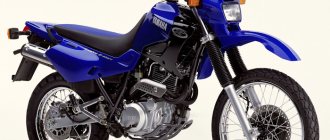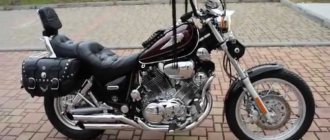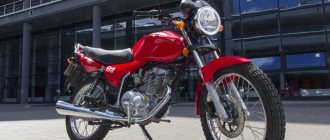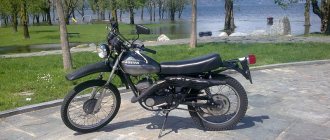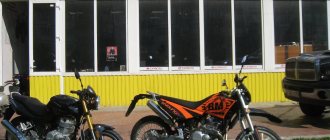Yamaha XT660R, Honda Transalp 650
From MotoDrive No. 7, 2006Daily driving along the capital's streets is a no-no, and it even makes you think that it would be a good idea to find a replacement for your faithful road worker. A motorcycle capable of not only accelerating quickly and squeezing through everywhere, but also moving off the beaten track, without risking the driver’s health.
As you can guess from the portrait of the “suspect,” we are talking about enduro, preferably with a Central European cubic capacity of 600 cm3, give or take a little. The Western market is quite saturated with such products, and we have plenty to choose from: Honda Transalp, BMW F650GS, Kawasaki KLR-650. However, all these models have been present on the domestic market for several years now, but the Yamaha XT660R, which appeared in dealer showrooms last year, can be considered a relative newcomer, and therefore is of greater interest. To make our judgments more reliable, we found a competitor in terms of class and capacity to pair with the Yamaha: Honda XL650V (Transalp). So, a few words about the subjects. Externally, the XT looks very “cocky”, showing with all its appearance that it is a “hard” enduro. You can no longer classify him among the parquet hulks that are so popular today (his pedigree obliges him). And “XT-shka” can rightfully be proud of its ancestors, because the series appeared back in 1976 (just think!). The first generation was equipped with a 500 cc single-cylinder four-stroke engine and was the most thoroughbred enduro: a duplex frame, long-travel suspensions, a high-torque air-cooled engine, and a high-mounted muffler. The “Pyatisotka” became not only a commercially successful motorcycle, but also a two-time winner of the Paris-Dakar rally in 1979-1980.
In 1984, the Japanese company significantly modernized the motorcycle. The power unit was actually developed anew, increasing the displacement from 499 to 595 cm3 and installing a four-valve cylinder head instead of a two-valve one. A disc brake appeared at the front (on the XT500 both mechanisms are drum), and the rear suspension acquired a monoshock absorber. By 1990, the bike was updated with a rear disc brake and an electric starter. The motorcycle has gained “the fame of a steadfast tin soldier” with an indestructible engine. Weak points included a poorly functioning gearbox, as well as an insufficiently rigid (by today's standards) frame. The next global step in the history of the XT family was made in 1991. The newcomer XTZ660 was a real technological breakthrough: the 659 cm3 engine was equipped with liquid cooling and a five-valve cylinder head. Redesigned frame, two disc brakes and 48 hp. Off-road fun is what the XTZ is all about. However, the technically advanced, but not standard (in terms of reliability) motorcycle did not fulfill the role of flagship of Yamaha’s all-purpose off-road army. In 2004, the design headquarters 'before the release of a successor that should proudly carry the banner of the XT series. As for Honda, the Transalp is not one iota inferior to the XT660R in terms of pedigree, and in terms of the “hit index” it easily puts it in the belt. The history of the bike began in 1986 with the appearance of a 600 cc version of the dual-purpose motorcycle. Without further ado, a V-shaped two-cylinder unit with three valves per cylinder was taken from the Shadow 600 chopper, “charging” it into an enduronic chassis. Initially, the motorcycle was equipped with a single-disc front brake and a drum mechanism at the rear. In 1991, the rear drum was replaced with a full-fledged disc brake, and the first restyling had to wait until 1994. It was then that the motorcycle acquired exterior features that have largely been preserved to this day. In 1997, the motorcycle was equipped with a double-disc front brake, and 1999 brought the most serious modernization of the machine, namely: an increase in engine displacement to 647 cm3, as well as a complete change in appearance.
So, the official part seems to be over, now it’s time to move on to informal communication. Both motorcycles are tuned. Added to the standard equipment are hand guards, crash bars and saddlebag mounts. The XT660R also comes with an analogue tachometer and GPS mount, while the Transalp comes with a center stand, high Rhental handlebars (with bar) and MRA touring glass. An external examination provides the first food for thought: although the motorcycles belong to the same class is beyond doubt, some conceptual differences are still immediately visible. The XT660R actively “mows” under a cross-country bike. This is evidenced by the high front fender, tapering closer to the fork, and the low tank, which goes under the long saddle. A small headlight, made in the “hard enduro” style, fits well into the “combat” look of the motorcycle and there is no fairing, not even the slightest bit, here, only a small visor above the headlight. As befits a motorcycle that claims, if not the title of conqueror, then certainly an off-road regular, there is one disc brake with a diameter of 298 mm and a two-piston caliper installed in front. The rear set is also standard: one 245 mm disc. The suspension travel is quite large - 225 and 200 mm, respectively, for the front and rear wheels. Transalp, in turn, immediately declares its touring abilities: it is equipped with a developed fairing with glass, and the seat is quite low (840 mm), wide and soft. Sitting on it, you can travel hundreds of kilometers, which cannot be said about the “millimeter perch” of the XT, located at a height of 865 mm. Honda's suspension travel is smaller than Yamaha's, amounting to 200 and 172 mm for the front and rear wheels, respectively. Ground clearance of 192 mm is quite sufficient until you realize that on the XT it is 210 mm. Add here the difference in suspension travel, and the thought involuntarily arises that Transalp “has come to the wrong address.” But it is not so. You can understand the driving difference between these two enduros only by riding them alternately, which is what our testers did, because no matter how much you read into the technical characteristics, you cannot understand the character of the motorcycle. Therefore, just try!
Valery Garbaruk (Height 170 cm, weight 72 kg). The Yamaha XT660R is very tall, even though I can reach the ground with both feet, I still have to stretch hard. The steering wheel is located quite close, or rather, you sit close to the steering wheel, but there seems to be no tank in front of your feet, it is small, narrow, and smoothly merges with the seat. The seat is also narrow and long, the fit is almost cross-country. Immediately there is a desire to go off-road, into the forest. The seating position of the Honda Transalp is completely different: the seat is wide and noticeably lower, I can easily reach the ground with my feet with bent knees. The steering wheel is much higher and further (the “native” handles are 10 cm lower). At maximum eversion, you have to reach for the outer handle and lean forward. Inconvenient. Given my height, this is too high for me, I would give it a standard one. But for a tall owner - just right! There is a spacious tank between the steering wheel and the seat. Overall, the riding position is like that of a classic road bike. It should be remembered that an enduro is a dual-purpose motorcycle, so performance on asphalt and dirt is equally important. So let's start with asphalt. Yamaha, after starting the engine, fills the space with the sound of a “one-pot” large-displacement engine. At the same time as filling the space with a pleasant sound, the driver’s body is filled with vibration generated by the same single-piston engine. How does it start? The starter, howling strainedly, turns the crankshaft with difficulty. It seems that the battery is dead and the speed is too low to start, but literally from the second revolution the engine picks up and rumbles steadily at idle. But what will the start be like when the battery really “runs out”?.. Honda starts smoothly, without attracting undue attention to this process. Compared to the XT, its engine “buzzes” as much as a V-twin can buzz. Vibrations on the steering wheel are not felt at all (after all, it is mounted on silent blocks), and the motor itself is well balanced. Even before the comparative test, I rode the XT around the city for several days and formed a strong opinion about this motorcycle. After many years of enduring love for sportbikes, I was interested in riding an enduro around the city. The suspension completely eliminates the need to look at the road surface, freeing up some of your attention to see what is happening around you, which is nice. Only a deep hole with sharp edges can perhaps penetrate the tire to the rim, but such a hole must first be found, and then not even noticed. In general, I quickly stopped looking at the asphalt. Moreover, the worse the road, the greater the advantage you get over cars. When the right lane of the road is broken and cars are ignoring it, it’s the best time to pass everyone on the right. When cars go “forty” on broken asphalt, you can drive about “a hundred” on an enduro and smile. This enormous superiority is lost as soon as you get onto a good avenue. Cars travel about a hundred and a motorcycle - almost the same. It is no longer possible to overtake easily: there is not enough dynamics, and the desire to be “fast” quickly disappears. Starting from a traffic light, naturally, you move away from the flow of traffic and, quickly going through gears, reach sixth. The shift foot travel is large, although the effort is minimal. You can shift seamlessly and smoothly without touching the clutch. Having reached a comfortable speed, you stop accelerating. If you look at the speedometer, there will be numbers in the range of 100-120. This is the speed at which this motorcycle travels. Before her, he is very dynamic and cheerful. Afterwards I feel sluggish and scary. Naturally, he can go faster, but he needs to force himself to do it. And sometimes I forced it. After “120” the motorcycle’s reactions become blurred, and the road is not felt at all. The reason for this may be that the suspension is too soft for high speeds, and the frame is not too rigid, but rather both, plus the wind into the bargain. If you pack up and go “150-160”, then the behavior of the motorcycle will resemble a good paper kite, which sways a little to the right and left without touching the ground. Any maneuver requires caution and plenty of space. After a minute of driving like this, you let off the gas and go comfortably to a hundred. The brakes are not impressive at all. The braking distance is too long, the information content of the procedure is low. When braking aggressively, you need to pay a lot of attention to the force on the handle, trying to detect the beginning of blocking by the noise and squeaking of the rubber, while the motorcycle yaws, but there is no expected deceleration. This has a big advantage: you start to drive more carefully, so that powerful braking is not required at all. So this motorcycle is conducive to quiet city riding. The engine revs easily, has a noticeable pickup from 4500 rpm, lasting until 6000, which is pleasant. However, as soon as you open the throttle at revs below the number “2000”, loud knocks become audible, which forces you to immediately downgrade the gear. Under load, “from idle” the engine has no luck at all, loudly resisting this mode. Some skill is required from the driver in order not to lower the speed (despite the fact that there is no tachometer in the standard instrument panel). That's why there's an optional tachometer. I got on the Honda Transalp. You immediately feel a different character. There are no vibrations at idle at all. The engine picks up speed smoothly from 1000 to the red zone. Convenient, pleasant, quiet, though without mischief. Just like that, picking up speed evenly, the motorcycle accelerates quite briskly, imperceptibly passing between 0 and 120. You stop accelerating when the standard tachometer shows 6500 rpm and the speedometer shows 140 km/h. The Honda's chassis behaves noticeably better at high speed than the Yamaha's. The presence of a front fairing and high glass works to significantly increase the average comfort component. Even if at a speed of “150-160” it is not a sportbike in terms of the severity of its reactions, but it is far from being a “kite”. The brakes are noticeably more powerful and more informative. I even got down to look at the brake mechanisms, they pleased me so much. I look and can’t believe it: two small discs on the front wheel, but they work much better than the one big one on the Yamaha XT. Gear shifting occurs with such minimal foot travel, as if it were a sportbike. In city mode, the comfort of the suspension is almost identical to that of the XT. You can drive without choosing a road and without having to slow down in front of a speed bump. The character is very even, roadworthy, reliable, but I still don’t want to go into the “swamp”. I'm thinking about where I'd like to go on this bike. Probably to the Crimea or the Carpathians to climb a dirt road to the mountain there. This, in my opinion, is just for him. Transalp definitely won the asphalt part of the test. And I drove it like a winner into the forest, to the lake, where the soil is sandy. On dense soil the motorcycle rides as if it were on asphalt, even if you accelerate to 100 km/h, if you manage to turn later. On a loose sandy road the feeling is much worse. The motorcycle yaws, floats on the sand, requires a lot of effort to maintain its trajectory, but still holds it. Driving slowly is more difficult than driving fast. The only thing that saves you is driving with gas. If you drive with slight acceleration, the rear wheel slips and, slightly wiggling its “butt,” the motorcycle accelerates in the given direction. But he frankly doesn’t want to turn on loose soil. When moving evenly, as soon as you turn the steering wheel, the front wheel slides outward and you can fall. There is only one way to make it turn: to tilt it and, even before the front wheel drifts, open the gas with excess, causing the rear wheel to skid. The motorcycle hangs in a skid for a long time and you need to make an effort to straighten it out. The heavy weight and the Bridgestone tires are not “evil” enough for the ground. At the same time, the ground clearance and crankcase protection allow you to cross even a deep rut, the eyes see the obstacle, it seems that you cannot move, and the suspension gently “swallows” the barrier and the motorcycle rolls without hesitation. I once experienced the same feeling when I first sat on a motocross motorcycle: you can ride wherever your eyes take you. Having changed to the XT 660 and driven around the circle I had just ridden on the Transalpa, I burst into a smile and shouted to our photographer: “Bicycle!” After the Honda, the ease of control on “creeping ground” is especially striking. The tires are the same, “not evil,” but the front wheel carries less, and it’s easier to cause a skid and to control it. The engine response is instantaneous, and they want to constantly play, starting to slip where it is necessary and where it is not necessary. Should I turn around? You lock the rear wheel with the brake, start to turn, then throw the clutch, skid, slip - and you've already turned. When I tried to slowly drive up the hill, I still stalled. The tires have failed, they regularly scrape the soil out from under the wheel, but in such small portions that they do not push forward. So I dug in. No need to drive slowly! More “gas” is the saving recipe. You sit high, very much like a motocross motorcycle, only much softer in reactions. I just want to ride, go crazy, throw sand. We found a path going steeply down, I drove along it twice, and on the third I took it and jumped off. The result was a jump from a height of one and a half meters onto a plane. Right next to our photographer. Michel says that the motorcycle landed very loudly, even the ground shook, yet it is one and a half times heavier than a sports “cross bike,” but the suspension worked so softly that I, being in the boots, did not receive a blow to my legs. Shine! In my opinion, more than enough for a “non-racing” motorcycle. After the springboard we went to the beach to “make splashes.” “They splashed” so much that water overflowed through the windshield! The idiots gathered to watch us drown the motorcycle, but it had no intention of sinking. Each time they took me out of the water wet but happy. A lot of fun is hidden in this motorcycle, but to get it to the fullest, you need to put on motocross tires, forget about the asphalt, and ride wherever your eyes take you. On the sand you don’t feel, but rather simply don’t pay attention to, the vibration coming from the engine, and the off-road brakes are excellent, and the narrow long seat allows you to move, changing the weight distribution of the motorcycle. Yamaha wins on dirt! What about Honda? Its cross-country ability is almost equal to that of a Yamaha, the tires are the same, the ground clearance is almost the same. The air intake is also located high, you can drive into the lake to the same depth. It seems that everything is similar, but I don’t want to, it doesn’t provoke the motorcycle to do it. Go off-road? You're welcome! But he doesn’t want to be a hooligan. A real tourist with fairly wide off-road capabilities. Valery Chuikov (Height 186 cm, weight 110 kg). I've always wanted to have an enduro bike as a second bike. There are several reasons for this. The first is that the quality of the roads in Ukraine, unfortunately, leaves much to be desired (on my previous motorcycle, the shock absorbers “died” after twenty thousand kilometers of driving on them). The second is that riding a large touring motorcycle in a big city is inconvenient and difficult. Its "passability" in traffic jams is only slightly better than that of a small car, that is, the main qualities of the motorcycle - compactness and maneuverability - suffer. The third reason is that nature beckons, and very often. When traveling, you want to get off the asphalt and, having made your way along a forest path, end up on the shore of a lake or by a mountain river, where it’s absolutely impossible to get to by car, but easily with an enduro! Ultimately, I came to the conclusion that we need a not too big (but at the same time rather large) “universal soldier” who will jump over curbs and “seep between cars”, and if necessary, then on any primer ( or grass) will climb (or descend) the hill. I chose the Honda Transalp. There was an idea to take an Africa Twin, but in six months I couldn’t find a single suitable copy, and it weighs a good “fifty dollars” a kilo more. The reliability of Transalp is legendary, and in terms of ergonomic indicators I am quite satisfied with it, especially after installing high glass and steering wheel. The wind begins to bother you only after 140 km/h, and thanks to the Rhental steering wheel, the mirrors of ALL passenger cars (except perhaps jeeps and minibuses) remain under its handles when traffic jams “creep”. I ride this motorcycle around Kyiv almost every day, getting a lot of pleasure. The thrust is literally “locomotive”, right from idle, while the acceleration dynamics allow you to “walk” along the rows in the stream, and to easily break away from the crowd of cars starting from a traffic light. Even going down steps is not a problem thanks to the decent ground clearance. Very powerful front brakes require careful handling on slippery surfaces, quickly blocking the front wheel, but it’s not easy to skid the rear wheel, but even if this happened, the bike itself easily stabilizes, you just need to slightly loosen the pressure on the foot. I also made a long-distance run on it with a passenger. Despite some deterioration in acceleration dynamics due to the load, it is still quite decent for overtaking, but what can you compare with the thrill of driving at a cruising speed of 120-130 km/h, when it doesn’t matter what quality of asphalt lies under the wheels. Yes, if only he was! And even if it’s not there somewhere along the road, the superiority in speed over the cars crawling nearby will comfort you enough. Yes, with all-terrain tires, the Honda XL650V loses the serious off-road battle to the Yamaha XT660R. But how it wins in everything else, from comfort to tourism opportunities! I also liked “HT-shka”... But only for a short time. Yes, it is already larger and makes its way through traffic jams more quickly, but at the same time it brakes worse. Yes, there is a real “undermining” on the handle. It’s probably not difficult to put it in the “goat”, but you’ll have to get used to the vibration, if you can get used to it. And off-road... Extreme driving on sand or mud is certainly easier than the Transalp, but for some reason it seems to me that anyone who needs SUCH extremes will buy either a hard-enduro with an engine of no more than 400 cm3, or even a cross-country bike "to have a blast. The XT is still too heavy for this, and the difference between them in the ability to overcome this or that off-road obstacle is minimal, as I was able to notice. So my conclusion after the test is this: both the Yamaha XT660R and the Honda XL650V are quite suitable for overcoming moderate off-road sections, or for driving on dirt roads approximately equally. But the payload when delivering you with a passenger and cargo to these areas, and even more so, the comfort and speed of such delivery already vary significantly. So, if you want to “mix mud” or overcome a couple of fords, when these places are relatively close to your permanent place of residence, do it on the “HT-shka”, but if you want to go far (for example, like me , to Armenia), in order to MAKE A TRAVEL on and without roads, and between the planned routes with pleasure to drive around the city every day, then without a tourist enduro it will be a little difficult for you, yes... PS In the 2006 model year, the Honda XL 650V received white turn signals and a tail light , but technically remained the same as the 2002 model used in the test.
Text: Denis Los Photo: michel
Video
- A quick look at the Yamaha XT660Z Tenere motorcycle.
- A short test of the Yamaha XT660Z Tenere motorcycle.
Yamaha XT660Z Tenere
- medalist and winner of the famous Paris-Dakar race. The feeling of personal impunity is present from the first meters of the ride behind the wheel of the Yamaha XT660Z Tenere. The main thing is not to get carried away and not to become impudent - the rules of the road are the same for everyone! And it’s better to release the energy somewhere on a difficult journey, since this enduro was created specifically for long journeys.
The seating position on the XT660Z is high, from above you cover the entire flow and perfectly “read” all the intentions of the cars on the track. The seat is quite hard, but the soft long-travel suspension makes riding this motorcycle extremely comfortable.
The Yamaha XT660Z Tenere 660 cc water-cooled engine ensures you won't overheat in traffic or when conquering mountain passes. The dynamics of acceleration are simply hurricane-force for a motorcycle of this class; you get less adrenaline from running this enduro and slalom in traffic jams than on a sportbike.
Fans of long-distance travel will be pleased with the durable steel frame and reinforced chassis; those who are also thinking of buying a Yamaha XT660Z Tenere for long-distance travel will like the ability to install large panniers on the frame. On a broken road, where all other motorcycles and cars crawl like turtles, you can go far ahead on this Yamaha.
Brief history of the model
1991 – production and sales of the Yamaha XTZ660 Tenere model began. The first generation of the motorcycle. Features a rectangular headlight. Maximum engine power is 48 hp, torque is 57 Nm. Model: Yamaha Tenere 660 (XTZ660) (Europe). Factory designation: 3YF1, 3YF2, 4BW1.
1992 – no significant changes. Model: Yamaha Tenere 660 (XTZ660) (Europe). Factory designation: 3YF3, 3YF4, 3YF5, 4BW2.
1993 – no significant changes. Model: Yamaha Tenere 660 (XTZ660) (Europe). Factory designation: 3YF6, 3YF7, 3YF8, 4BW3.
1994 – Second generation of the motorcycle. Instead of a rectangular headlight, the model is equipped with a double round one, and the design of the dashboard changes. Due to the update of environmental emission standards, the model has become a little “stifled” - 46 hp. power, 56 Nm of torque. Model: Yamaha Tenere 660 (XTZ660) (Europe). Factory designation: 4MY1, 4MY2, 4NW1.
1995 – the model is temporarily not produced.
1996 is the last year of production. Model: Yamaha Tenere 660 (XTZ660) (Europe). Factory designation: 4MY3, 4MY4, 4NV2.
1999 is the last year of official sales.
Specifications
Technical characteristics of Yamaha XT660Z Tenere:
| Model | Yamaha XT660Z Tenere |
| Motorcycle type | touring enduro |
| Year of issue | 2008-2016 |
| Frame | steel |
| engine's type | 1-cylinder, 4-stroke |
| Working volume | 660 cm³ |
| Bore/Stroke | 100.0 x 84.0 mm |
| Compression ratio | 10.0:1 |
| Cooling | liquid |
| Number of valves per cylinder | SOHC, 4 valves |
| Fuel supply system | injector, 1x Mikuni 44 mm |
| Ignition type | digital TCI |
| Maximum power | 48.0 hp (35.3 kW) at 6000 rpm |
| Maximum torque | 60.0 Nm (6.1 kg*m) at 5250 rpm |
| Clutch | Multi-disc in oil bath, cable drive |
| Transmission | 5-speed |
| type of drive | chain |
| Front tire size | 90/90-21 M/C (54S) |
| Rear tire size | 130/80-17 M/C (65S) |
| Front brakes | 2 discs, 298 mm, 2-piston calipers (XT660ZA – ABS) |
| Rear brakes | 1 disc, 245 mm, 1 piston caliper (XT660ZA – ABS) |
| Front suspension | 43mm telescopic fork (preload adjustable), 210mm travel – XT660Z Tenere 43mm telescopic fork (preload adjustable), 160mm travel – XT660Z Tenere (ABS) |
| Rear suspension | pendulum with monoshock absorber (adjustable preload), stroke – 200 mm – XT660Z Tenere pendulum with monoshock absorber (adjustable preload), stroke – 145 mm – XT660Z Tenere (ABS) |
| Motorcycle length | 2246 mm |
| Motorcycle width | 864 mm |
| Motorcycle height | 1477 mm |
| Wheelbase | 1500 mm |
| Seat height | 896 mm |
| Minimum ground clearance (clearance) | 260 mm |
| Acceleration to 100 km/h | 5.7 sec |
| Maximum speed | 160 km/h |
| Gas tank capacity | 23.0 l (including reserve - 6.7 l) |
| Motorcycle weight (curb) | 208.5 kg – XT660Z Tenere 215 kg – XT660Z Tenere (ABS) |


